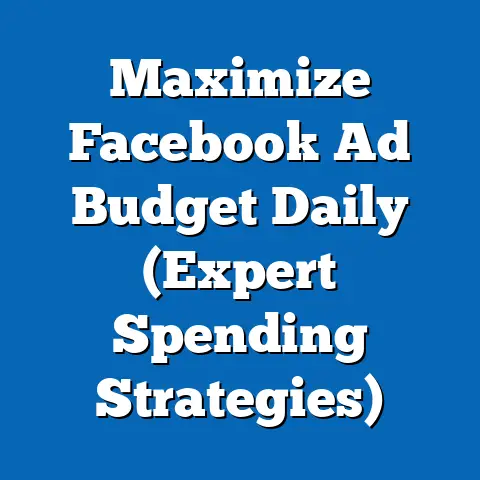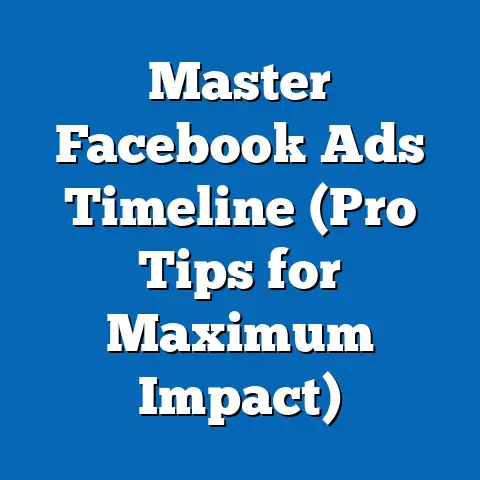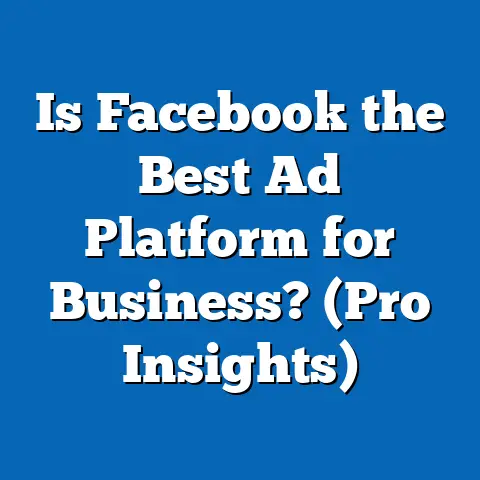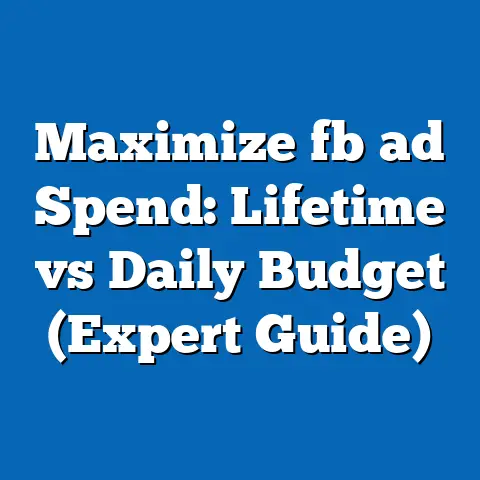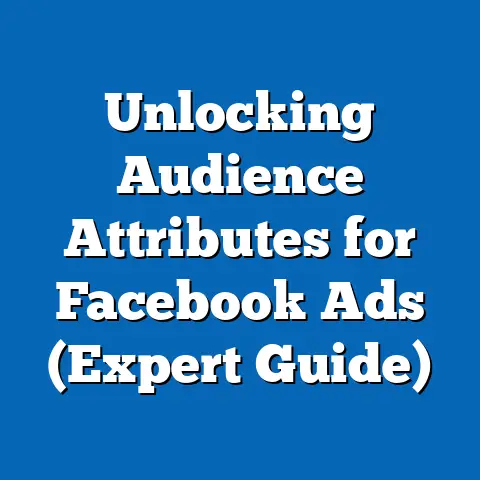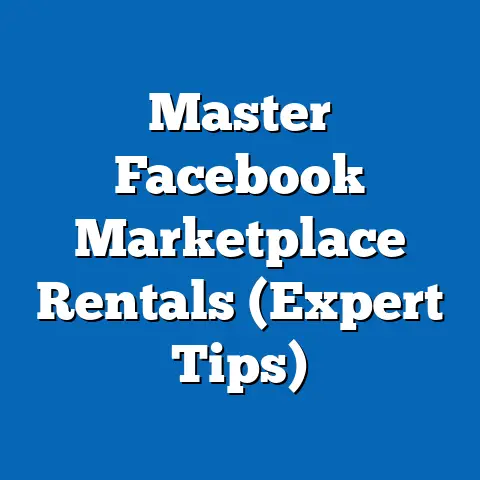Boost Sales with Amazon & Facebook Ads Strategies (Expert Tips)
In the rapidly evolving world of e-commerce and digital marketing, Amazon and Facebook stand out as titans of targeted advertising, offering unparalleled opportunities for businesses to boost sales. Recent data from eMarketer reveals that Amazon’s ad revenue reached $31.2 billion in 2022, a staggering 25% increase from 2021, while Facebook (under Meta Platforms) generated $113.6 billion in ad revenue, accounting for nearly 20% of the global digital ad market. These platforms cater to distinct yet overlapping demographics, with Amazon excelling in product-driven intent and Facebook dominating in social engagement and brand awareness.
What makes these platforms uniquely powerful is their ability to leverage vast troves of user data for hyper-targeted advertising. This article delves into the latest strategies for maximizing sales through Amazon and Facebook ads, supported by statistical trends, demographic insights, historical comparisons, and expert tips. We’ll explore how businesses can harness these platforms’ unique strengths, backed by data from authoritative sources like Statista, eMarketer, and industry reports, while providing actionable insights for 2023 and beyond.
The Uniqueness of Amazon and Facebook Advertising
Amazon and Facebook are not just advertising platforms; they are ecosystems built on user intent and behavior. Amazon’s strength lies in its position as the go-to marketplace for product discovery and purchase, with 63% of U.S. consumers starting their product searches on Amazon, according to a 2022 Jungle Scout report. This intent-driven environment means ads on Amazon often convert at higher rates—average conversion rates for Amazon Sponsored Products hover around 10-12%, compared to the broader e-commerce average of 2-3% (Statista, 2023).
Facebook, on the other hand, excels in building emotional connections and brand loyalty through its social-first approach. With 2.9 billion monthly active users as of 2023 (Meta Investor Reports), it offers unmatched reach across diverse demographics, making it ideal for awareness and retargeting campaigns. The platform’s ad engagement rate averages 0.9%, but its ability to drive long-term customer value through storytelling and community-building sets it apart (Hootsuite Digital Trends Report, 2023).
Together, these platforms create a complementary strategy: Amazon captures consumers at the point of purchase, while Facebook nurtures them through the awareness and consideration phases. This synergy is critical for businesses aiming to maximize return on ad spend (ROAS), with studies showing that combined campaigns can yield up to 35% higher sales lift compared to single-platform strategies (Nielsen, 2022).
Key Statistical Trends in Amazon and Facebook Advertising
Amazon Ads: Dominance in E-Commerce
Amazon’s advertising ecosystem has grown exponentially, with ad revenue projected to surpass $40 billion in 2023 (eMarketer). Sponsored Products, which appear in search results, account for 73% of Amazon’s ad spend, delivering an average ROAS of $3.50 for every dollar spent (Jungle Scout, 2023). This growth reflects a shift in advertiser priorities, as businesses increasingly allocate budgets to platforms with direct purchase intent.
Moreover, Amazon’s share of U.S. e-commerce sales reached 37.8% in 2022, up from 34.2% in 2020, underscoring its dominance in the retail space (Statista). Small and medium-sized businesses (SMBs) are particularly benefiting, with over 60% of Amazon sellers reporting ad-driven sales growth of 25% or more in the past year (Amazon Seller Central Report, 2022).
Facebook Ads: Social Reach and Engagement
Facebook remains a juggernaut in digital advertising, with its ad revenue growing by 12% year-over-year in 2022 despite economic headwinds (Meta Q4 Earnings, 2023). The platform’s strength lies in its ability to target users based on detailed behavioral and interest data, with 78% of advertisers citing audience precision as their top reason for using Facebook Ads (Hootsuite, 2023).
Video ads are a standout format on Facebook, driving 62% higher engagement rates compared to static image ads (Socialbakers, 2023). Additionally, Facebook’s integration with Instagram and WhatsApp amplifies its reach, particularly among younger demographics, with 71% of Gen Z users engaging with ads on these platforms monthly (Pew Research, 2022).
Demographic Breakdowns: Who’s Clicking and Buying?
Amazon Ads: Targeting the Intent-Driven Shopper
Amazon’s user base skews toward practical, purchase-ready consumers. According to Statista (2023), 54% of Amazon shoppers are aged 25-44, with a near-even gender split (51% male, 49% female). Income distribution shows that 62% of frequent Amazon buyers earn between $50,000 and $100,000 annually, reflecting a middle-class dominance in its audience.
Geographically, urban and suburban users make up 78% of Amazon’s ad-driven purchases, likely due to faster delivery options and higher digital adoption rates (Jungle Scout, 2022). For advertisers, this means tailoring campaigns to mid-income, family-oriented demographics with clear, product-focused messaging.
Facebook Ads: Capturing Diverse Social Audiences
Facebook’s demographic reach is broader, spanning multiple age groups and income levels. As of 2023, 31% of its users are aged 25-34, while 26% are 35-44, and Gen Z (18-24) accounts for 19% (Statista). Women slightly outnumber men (53% vs. 47%), and the platform sees strong engagement from lower- to middle-income brackets, with 58% of users earning less than $75,000 annually (Pew Research, 2023).
Notably, Facebook’s global reach offers unique opportunities for international campaigns, with 70% of its user base residing outside North America (Meta Reports, 2023). Advertisers can leverage this diversity by creating culturally relevant content and using Facebook’s Lookalike Audiences to target similar user profiles across regions.
Comparative Insights
While Amazon’s audience is laser-focused on buying, often within a single session, Facebook’s users engage over longer periods, making it ideal for retargeting and brand-building. For instance, 68% of Amazon ad clicks result in a purchase within 24 hours, compared to just 22% for Facebook (Nielsen, 2022). However, Facebook excels in customer lifetime value, with 45% of users returning to brands they’ve engaged with on the platform within a month (Hootsuite, 2023).
Historically, Amazon’s ad costs were lower, with cost-per-click (CPC) averaging $0.35 in 2016 compared to $1.10 in 2023 due to increased competition (Jungle Scout). This trend reflects a shift from a low-barrier entry point to a high-stakes arena where strategic optimization is critical for success.
Facebook Ads: Adapting to Privacy and Platform Changes
Facebook’s ad revenue grew from $17 billion in 2015 to over $113 billion in 2022, fueled by innovations like dynamic ads and mobile-first formats (Meta Earnings Reports). However, the platform faced challenges with Apple’s iOS 14 privacy updates in 2021, which limited tracking capabilities and caused a 10% drop in ad effectiveness for some advertisers (Forbes, 2022).
Despite this, Facebook adapted by enhancing machine learning algorithms and introducing tools like Advantage+ Shopping Campaigns, which automate ad placements. Historical CPC trends show a rise from $0.27 in 2015 to $0.97 in 2023, reflecting both increased demand and evolving user expectations for personalized content (WordStream, 2023).
Convergence of Strategies
Over the past decade, both platforms have moved toward greater integration of data and automation. Amazon introduced DSP (Demand-Side Platform) for programmatic advertising in 2019, mirroring Facebook’s long-standing strength in audience targeting. Meanwhile, Facebook’s e-commerce push through Shops and Marketplace features has encroached on Amazon’s territory, with 25% of users now discovering products directly on the platform (Meta, 2023).
Detailed Analysis: Expert Tips for Boosting Sales
Amazon Ads Strategies
1. Optimize for Keywords with High Intent
Amazon’s search-driven ecosystem rewards relevance. Use tools like Amazon’s Search Term Report to identify high-converting keywords and allocate 70-80% of your budget to exact-match campaigns (Jungle Scout, 2023). For example, a seller of fitness equipment might target “adjustable dumbbells 50 lbs” over generic terms like “weights” to capture buyers further down the funnel.
Focus on negative keywords to filter out irrelevant traffic, reducing wasted ad spend by up to 20%. Regularly update your keyword list based on seasonal trends—data shows a 30% spike in searches for “holiday gifts” in Q4 (Amazon Seller Central, 2022).
2. Leverage Sponsored Brands for Visibility
Sponsored Brands, which appear at the top of search results, drive 3x higher click-through rates (CTR) than Sponsored Products (Amazon Ads, 2023). Use custom images and headlines to showcase your brand’s unique value proposition, especially for categories with high competition like electronics or apparel.
Combine this with Storefronts to create a seamless brand experience, as 55% of users who click Sponsored Brands explore the associated Store (Jungle Scout, 2022). Allocate at least 15-20% of your ad budget to branding efforts for long-term customer loyalty.
3. Utilize Amazon DSP for Retargeting
Amazon’s Demand-Side Platform allows advertisers to target users across the web, not just on Amazon. Retargeting campaigns via DSP yield a 35% higher conversion rate for users who previously viewed a product (Amazon Ads Report, 2023). Use this to re-engage cart abandoners or upsell complementary products, such as targeting past buyers of running shoes with socks or fitness trackers.
Facebook Ads Strategies
1. Prioritize Video Content for Engagement
Video ads on Facebook generate 8x more engagement than static ads, with 85% of users watching videos with sound off (Socialbakers, 2023). Create short, visually compelling videos (15-30 seconds) with captions to convey your message instantly. For instance, a clothing brand might showcase a quick outfit transformation to grab attention.
Test carousel video ads to display multiple products, as they increase CTR by 20-30% compared to single-image formats (Hootsuite, 2023). Allocate 40% of your budget to video content for maximum impact.
2. Use Lookalike Audiences for Expansion
Facebook’s Lookalike Audiences allow you to target users similar to your existing customers, expanding reach by up to 50% without sacrificing relevance (Meta Ads Manager, 2023). Upload a customer list or use website pixel data to create a seed audience, then refine with interest-based layers like “fitness enthusiasts” for a gym product.
Combine this with retargeting campaigns for website visitors, as 70% of users who abandon carts return after seeing a retargeted ad (WordStream, 2023). This dual approach maximizes both acquisition and retention.
3. Test Dynamic Product Ads (DPA)
DPAs automatically showcase products from your catalog to users based on their browsing history, driving a 40% higher ROAS compared to standard ads (Meta, 2023). Sync your product feed with Facebook to ensure real-time updates on pricing and availability, especially during sales events like Black Friday, where DPA clicks spike by 60% (Socialbakers, 2022).
Focus on mobile optimization, as 78% of Facebook ad interactions occur on smartphones (Statista, 2023). Use bold visuals and clear CTAs like “Shop Now” to drive immediate action.
Synergistic Campaigns: Combining Amazon and Facebook
1. Drive Awareness on Facebook, Convert on Amazon
Use Facebook to build interest through storytelling ads, then retarget those users with Amazon Sponsored Display ads for conversion. Data shows that users exposed to both platforms in a campaign have a 28% higher purchase likelihood (Nielsen, 2022). For example, a beauty brand might run a Facebook video ad about skincare routines, then target the same audience on Amazon with product-specific promotions.
2. Leverage Cross-Platform Data Insights
Both platforms offer robust analytics—use Amazon’s Brand Analytics to understand search trends and Facebook’s Audience Insights to refine demographic targeting. Combining these datasets can improve campaign efficiency by 15-20% (eMarketer, 2023). Regularly cross-check performance metrics to allocate budgets dynamically based on ROAS.
Future Projections: What’s Next for Amazon and Facebook Ads?
Looking ahead, Amazon’s ad revenue is forecasted to hit $50 billion by 2025, driven by expansion into video streaming ads via Prime Video and increased adoption of DSP (eMarketer, 2023). Competition will likely push CPC higher, with projections estimating a rise to $1.50 by 2025, necessitating even sharper optimization strategies (Jungle Scout).
Facebook, meanwhile, is expected to grow its ad revenue to $150 billion by 2025, fueled by deeper integration with e-commerce tools and AI-driven ad personalization (Meta Projections, 2023). The platform’s focus on privacy-compliant targeting, such as first-party data solutions, will shape future campaigns, with 65% of advertisers planning to increase budgets for Advantage+ automated campaigns (Hootsuite, 2023).
For businesses, the implication is clear: a dual-platform strategy will become non-negotiable. As user behavior continues to fragment across intent-driven and social platforms, integrating Amazon and Facebook ads will be key to capturing the full customer journey. Experts predict that by 2025, 80% of successful e-commerce brands will allocate at least 50% of their digital ad budgets to these two platforms combined (Nielsen, 2023).
Conclusion: Building a Winning Strategy
Amazon and Facebook offer distinct yet complementary paths to sales growth, with Amazon excelling in conversion and Facebook leading in engagement. By leveraging data-driven strategies—such as keyword optimization on Amazon and video-driven storytelling on Facebook—businesses can achieve up to 35% higher sales lift compared to single-platform efforts. The key lies in understanding demographic nuances, adapting to historical shifts, and preparing for future trends like AI automation and privacy-first targeting.
As competition intensifies, staying ahead requires continuous testing, cross-platform integration, and a commitment to actionable insights. Whether you’re a small seller or a global brand, the expert tips outlined here provide a roadmap to boost sales and build lasting customer relationships in 2023 and beyond. With the right approach, Amazon and Facebook ads can transform your business from a market participant to a market leader.

